#Summer 2018 Survival Guide
Explore tagged Tumblr posts
Text
10 years ago, Batkid was battling bad guys and cancer — now he's 15 and healthy

Today, Miles Scott is a healthy teenager with a passion for baseball. He plays catcher for his high school in Tulelake, Calif. "I wear all-black in baseball," Miles said. "So the dugout's always screaming 'Batkid! Batkid!'" Ten years ago, the then-5-year-old Miles won hearts both in his hometown and around the world when he transformed into the black-clad superhero Batkid for a day, becoming an instant media sensation. The Make-A-Wish Foundation, a non-profit that grants wishes to children who are seriously ill, partnered with the City of San Francisco to organize the adventure for Miles, who had been battling acute lymphoblastic leukemia since he was just 18 months old. According to the Yale School of Medicine, the disease is the most common type of childhood cancer. Survival rates used to be low, but these days children with the disease have up to a 90% chance of going on to lead a healthy life. Granting the wish Make-A-Wish went to elaborate lengths to make Miles' dream of becoming Batman's sidekick Batkid true. The foundation enlisted the help of The Mayor of San Francisco (the late Ed Lee), the San Francisco Police and Fire Departments, the San Francisco Giants and many other individuals and entities. San Francisco was re-dubbed "Gotham City" — Batman's fictional home — for the day. Clad in his Batkid costume and accompanied by a grownup Batman (played by Eric Johnston), the pair zipped around in their Batmobile thwarting villains — they prevented The Riddler from robbing a bank vault — and undertaking daring rescues, including freeing the San Francisco Giants' mascot Lou Seal from The Penguin's clutches.
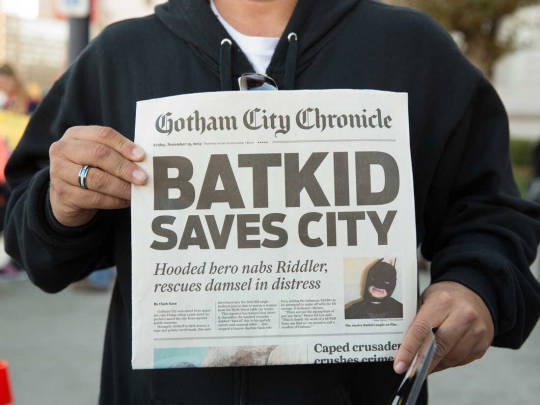
Thousands of people descended on San Francisco to cheer Miles on. He earned a key to the city. The San Francisco Chronicle published a special edition of its daily newspaper to mark the occasion. Then-U.S. President Barack Obama sent Miles words of encouragement via a video message on social media. "The feeling was palpable; you could just feel the positiveness and how the community came together," said Miles' mom, Natalie Scott. "People flew in from everywhere and it just gave everyone some sense of peace almost." The event was covered by many mainstream media organizations, including NPR. And millions of people around the world followed the #Batkid hashtag on social media. Batkid lives on Batkid's legacy didn't end on that day.
The wish was the subject of the 2015 Warner Bros. documentary, Batkid Begins. Media organizations have revisited the story over the years. "He plays Little League, attends fifth grade, helps on his family's farm and sold his first market goat at the fair over the summer," reported his hometown California paper, The Siskyou Daily News, on Batkid's fifth anniversary in 2018.
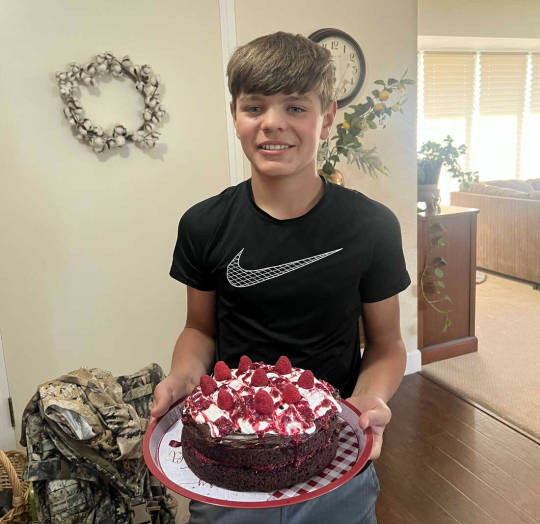
And Miles himself has been free of cancer for the past few years. "Every year he goes for a checkup, and everything's been on the straight and narrow, so, we hope to keep it that way," said Nick Scott, Miles' dad. Miles has grown out of his Batkid costume. But his kid brother Ben donned it last Halloween. Miles is now in high school and is looking ahead to the future. "Right now, he's dead set on going to Alaska and being a 'pack mule' for his cousin's husband's guide business," said Natalie Scott. "And he has a lot of interest in welding. So we'll see!"
94 notes
·
View notes
Text
April 2024 Reads





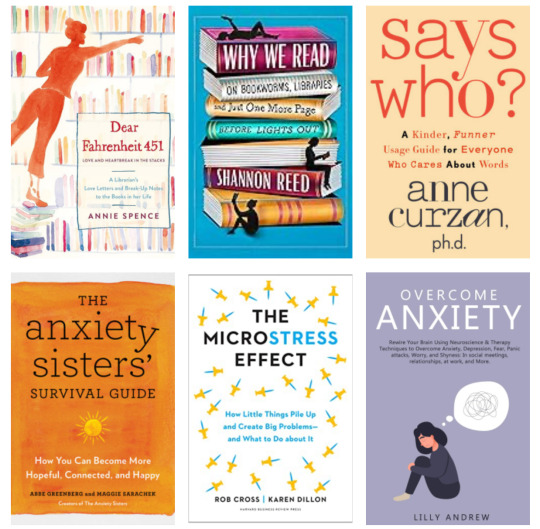
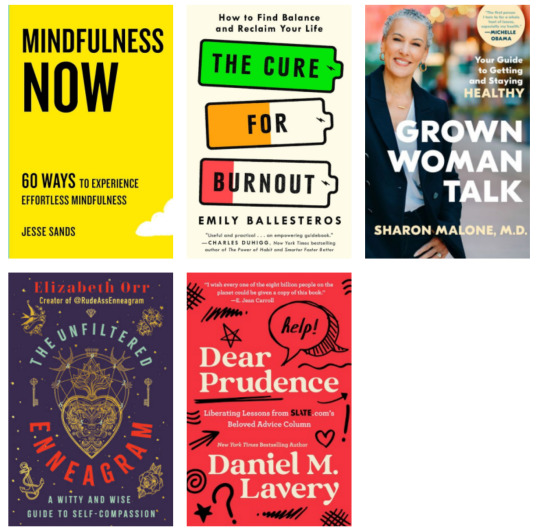
Just for the Summer - Abby Jimenez
Only and Forever - Chloe Liese
Say You'll Be Mine - Nana Kumar
The Governess's Guide to Passion and Peril - Manda Collins
The Lying Game - Sara Jane Woodley
The Prospects - K.T. Hoffman
The Husbands - Holly Gramazio
Begin Again - Helly Acton
One Moment - Becky Hunter
Finlay Donovan Rolls the Dice - Elle Cosimano
Interesting Facts About Space - Emily R. Austin
Nothing to See Here - Kevin Wilson
The Tusks of Extinction - Ray Nayler
The Reappearance of Rachel Price - Holly Jackson
Every Time You Hear That Song - Jenna Voris
Rules for Rule Breaking - Talia Tucker
Hawkeye, Volume 3: L.A. Woman - Matt Fraction
No One Returns from the Enchanted Forest - Robin Robinson
Dear Sophie, Love Sophie - Sophie Lucido Johnson
Out of Left Field - Jonah Newman
Continental Drifter - Kathy MacLeod
Fiona the Hippo - Richard Cowdrey
Woodland Dreams - Karen Jameson
Mushroom Rain - Laura K. Zimmermann
Bluets - Maggie Nelson
Sociopath - Patric Gagne
Grimoire Girl - Hilarie Burton Morgan
I Am the New Black - Tracy Morgan
The 2000s Made Me Gay - Grace Perry
The Bookseller at the End of the World - Ruth Shaw
Dear Fahrenheit 451 - Annie Spence
Why We Read - Shannon Reed
Says Who? - Anne Curzan
The Anxiety Sisters' Survival Guide - Abbe Greenberg, Maggie Sarachek
The Microstress Effect - Rob Cross
Overcome Anxiety - Lilly Andrew
Mindfulness Now - Jesse Sands
The Cure for Burnout - Emily Ballesteros
Grown Woman Talk - Sharon Malone
Unfiltered Enneagram - Elizabeth Orr
Dear Prudence - Daniel M. Lavery
Bold = Highly Recommend Italics = Worth It Crossed out = Nope
Thoughts:
A few standouts this month: Only and Forever brings the Bergman Brothers series to an end, and it was a worthy wrap up to these stories featuring MCs with disabilities and neurodivergence.
Just for the Summer is my new favorite Abby Jimenez book with several laugh out loud moments - especially the raccoon scene - which was hilarious on audio.
The Bookseller at the End of the World is not the cozy bookseller tale you might expect. Ruth led a varied and adventurous life filled with heartbreak and hope.
And I really enjoyed Says Who? - a super accessible and fun guide to English style and grammar.
Goodreads Goal: 150/200
2017 Reads | 2018 Reads | 2019 Reads | 2020 Reads | 2021 Reads |
2022 Reads | 2023 Reads | 2024 Reads
22 notes
·
View notes
Text

A Spotless Giraffe, Pictured in Namibia 🇳🇦, was seen and photographed for the first time in the wild just weeks after another animal with this type of coloring was born at a U.S. 🇺🇸 Zoo. Photograph By Eckart Demasius and Giraffe Conservation Foundation
Another Rare Spotless Giraffe Found—the First Ever Seen in the Wild
The sighting occurred just weeks after the unusual condition was seen in a newborn giraffe at a Tennessee zoo. Is it more common than scientists thought?
— By Dina Fine Maron | September 12, 2023
Just weeks after a giraffe at a U.S. Zoo was born missing its characteristic spots, another spotless giraffe calf has now been seen and photographed in the wild for the first time.
The unprecedented sighting occurred at Mount Etjo Safari Lodge, a private game reserve in central Namibia. Tour guide Eckart Demasius saw and photographed the solid-brown calf during a game drive on the roughly 90,000-acre reserve, according to the Giraffe Conservation Foundation. Demasius, who was not immediately available for comment, shared his photos with the giraffe nonprofit.
Sara Ferguson, a wildlife veterinarian and conservation health coordinator at the foundation, says the two recent spotless sightings are pure coincidence and that there’s no data to suggest this coloring is occurring more frequently than it had in the past.
This finding is just another example of “the weird way the world works” she says, adding that she’s “so amazed and pleased there is so much more to learn and discover about giraffe.”
Genetic Anomalies
The spotless reticulated giraffe born at Brights Zoo in Limestone, Tennessee, earlier this summer was recently named Kipekee, which means “Unique” in Swahili. The recent wild sighting occurred in another giraffe subspecies found in southern Africa, the Angolan giraffe.
Before these recent births, a giraffe with all-brown coloring was last seen at a Tokyo Zoo in 1972.

The spotless giraffe and its mother were photographed on a reserve with around 800 giraffes in central Namibia 🇳🇦. Photograph By Eckart Demasius and Giraffe Conservation Foundation
Scientists, including Ferguson, believe the solid coloring is likely due to one or more genetic mutations that haven’t yet been identified.
Some aspects of giraffe spots are passed down from mother to calf, according to a 2018 study in the Journal Peer J, and larger, rounder spots appear to be linked to higher survival rates for younger giraffes, but the reasons for that remain unclear.
Derek Lee, a Biology Professor at Penn State University and a co-author on the PeerJ Study, says that technically these two recent examples are not spotless animals, but instead —"one-spot-all-over giraffes."
It’s impossible to say what this genetic anomaly means for the animal’s health, he says, but there’s no evidence the color difference puts the animal at a disadvantage.
“We have a sample size here of one, so time will tell what happens.”
#Spotless Giraffe 🦒#Dina Fine Maron#Mount Etjo Safari Lodge | Namibia 🇳🇦#Giraffe Conservation Foundation#Sara Ferguson#Genetic Anomalies#Brights Zoo | Limestone | Tennessee#Kipekee | Unique#Angolan Giraffe 🦒#Tokyo Zoo | Japan 🇯🇵#Journal Peer J.#Derek Lee | Biology Professor | Penn State University#Namibia 🇳🇦 | US 🇺🇸
4 notes
·
View notes
Text
Stephen Gariepy - phaware® interview 508
Canadian resident, Stephen Gariepy, was diagnosed with Chronic Thromboembolic Pulmonary Hypertension (CTEPH) in 2018. After initially being active in senior hockey, his condition worsened, leading to difficulty breathing and performing daily tasks. Gariepy continues to live with this rare and terminal disease, adapting to the limitations it imposes on his daily life.
My name’s Stephen Gariepy. I’m from Edmonton Alberta in Canada. I was first diagnosed with CTEPH in 2018. What had happened was I had just recently retired and was beginning to enjoy retired life. I had joined a senior hockey league and was very involved in that playing hockey three times a week. Of course, everything came crashing down with this diagnosis. Every September I’d go out and do some recreational skating and preparation for the season openers, in October. I had started my skating program. There was a large clock on one of the ends of the rink, and I always use that to guide how my times were doing. I was noting there was a little improvement. I’m going, “Wow, I must have really got out of shape this summer.” So I continued my skating, was getting nowhere with it, so I figured, “Oh, well, I’ll be like the other guys and I’ll just play into shape.” Fortunately, I was able to do a couple of games, but my breathing was very compromised. I didn’t know what was going on. Then, I got a shoulder injury and that pulled me out of hockey and then I could concentrate on why I wasn’t breathing. This progressively really got worse to the point… I live in a two-story house and I was barely making it up the stairs. It was just ridiculous. I didn’t know what was going on. Fortunately, my GP I’ve had for 30 years, so the familiarity with me and him was very fortunate, because I went in to see him explaining what was going on. He could visibly see I couldn’t even breathe. So we set up a bunch of tests. He was able to pick off right from the original chest X-ray that it appeared that I might have pulmonary hypertension. What he did with that was completed the rest of the tests, sent in the referral to the Pulmonary Hypertension Clinic in Edmonton. I was able to get in there within the usual four to six weeks. I got my appointment there. I met with the specialist. They did a CT scan during the appointment and an ECG. I got lost in emergency somewhere, because they couldn’t fit me in anywhere. I had to go through the emergency system. During my appointment, finally, around 9:00, I was able to get it done. Fortunately for me, it proved the dedication of the staff at the Pulmonary Hypertension Clinic. It was a Friday night and the doctor waited until it came through. He was going to Disney World the next morning. I don’t know how he did it, but he stayed. Then, he came and got my wife and I from the emergency back to his office, back to the clinic. And he quickly looked at the CT scan and he advised me that yes, I had chronic thromboembolic pulmonary hypertension.
At that point, he told me the only option was if I had an operation, which would have to be done in Toronto, because they had lost their search and had Edmonton. They went at it right away. There was another test that was required for the surgeons in Toronto, which was the heart catheterization and some other test. I’m not sure what they all were. I was getting tested so much I couldn’t keep track anymore. Then, they had to set up a video interview with the surgeon in Toronto. That was Marc de Perrot. Great man, very impressive person. He determined that I was a candidate for a pulmonary thromboendarterectomy. They also noted that after the heart test and all that, they should probably do a bypass while I was opened up and that would allegedly make my heart stronger to survive the endarterectomy. So from October when I was diagnosed, I was able to get down to Toronto for the surgery. Of course, that came as quite an expense. The government did provide airfare and, of course, I had to travel with somebody, so I brought my wife. Then I had the surgery. It worked out to be, I think it was a little over 13 hours, because they had to do the bypass initially, and then they went in and did it. I was septic. I developed pneumonia twice. The real kicker here was that I turned out to have allergic reaction to the Heparin and then I developed a blood clot in my leg. The Heparin reaction like that is unbelievably rare. The only way they confirm it is to send your DNA to a laboratory in Hamilton, where then, of course, it was confirmed. To make it a long story short, ultimately it ended up the thromboendarterectomy being futile because I instantly re-clotted because of the Heparin allergy. With all the complications and everything, I wound up in Toronto in the hospital there for 45 days. I came out no better than when it went in, actually. Possibly a little worse. As I did not get better, I continued on with the Pulmonary Hypertension Clinic and they re-referred me back to Dr. Perrot in Toronto to look at other options. Ultimately, what was concluded was that I was too high of a risk to endure another pulmonary thromboendarterectomy, because of existing scar tissues and things of that nature just made the procedure too risky for me to have. But they did conclude that they could refer me to a vascular surgeon who could look at doing what’s called a balloon pulmonary angioplasty. That was arranged for me to go back to Toronto. That doctor said until he got in there, he couldn’t tell. Whether or not he could proceed with it, because if it was 100% blocked, he had nothing to work with, he couldn’t get a catheter around it. But he said he wouldn’t know that until he went in. But he saw some kind of backflow with the blood and figured he could attempt it. So I was scheduled to have it done again the next day for both lungs. He was able to get through, inserted a balloon in one lung. That worked in opening up one of the arteries. Then, he went in to the other lung and successfully opened that one as well, which was great. Then, we flew home. I felt much better. I was still on oxygen, but that didn’t last very long. At some point in the future, if I meet the requirements, I will be subjected to a lung transplant, but that’s down the road. I just take it every day by day, wake up in the morning and appreciate that I’m awake. On a humorous note here, what pulled me through the last time through the first endarterectomy was I said, “Please let me live so I can watch…” One of my daughters was just finishing off a degree, and I just wanted to be around for her to graduate. I take this as an omen. She was accepted for a post-graduate degree, but she started in September. So, I figured that’s got to give me two years because I have to see her graduate again! My wife just recently retired in June, which is fantastic because being alone with this thing, you’re just sitting at home dwelling on your illness, so it’s great. I have my partner back. We’re guardedly proceeding with our retirement and seeing what limitations I have. There’s all the flying restrictions. I have to go through all that kind of crap, but that’s just part of the disease and learning to live with it. I finally after years and years through the Pulmonary Hypertension Association of Canada, I was finally able to get hooked up with a PH buddy. I talked to him about twice, because he had had endarterectomy 10 years previous. After the 10 years he was deemed PH-free, so he kind of disappeared. I got to start working on that again. When I was diagnosed with CTEPH, the first emotion is, “God hates me. What did I do?” You get a diagnosis like this. First thing you do, like everybody does, you look it up on the internet. It says one to three years, you’re dead. God. You go through the five stages, right? Anger, denial, until ultimately you’re at peace with it. I know what I’m up against. I’ve been through it all and living day by day. I wake up, I’m happy I woke up. I do everything I possibly can. Of course, there’s good days and bad days. There’s days I can barely get out of bed, and there’s days I feel okay. Of course, if I go to cut the lawn, I’ll throw the oxygen tank on and get out there. I can’t do anything physical just the way it is, at least without oxygen. The surgery is a major surgery. It is huge. You’re made hypothermic. They stop your heart. They stop your brain. You’re clinically dead for 20 minutes for three periods, so you’re dead for an hour. The reality is that I’m living with a terminal disease. I realize that. I’ve gone through all the stages of grief and everything, and I just carry on. I know there is possibly a chance of getting a transplant down the road. By the time that happens, I wouldn’t even be eligible till I’m 70, and then the whole process will have to be reevaluated again. Until such time, I’m just going day by day, living with it, going through every emotion known to mankind. I got nothing left. I’m just living. It’s such a rare disease, you almost get tired of trying to explain it, so you say, “I’m sick.” There’s no denying it’s hard, what I’ve been through. I don’t think anybody’s been through, but I’m still here talking to you, so I’m winning. You just adapt and do what you can do. My name is Stephen Gariepy, and I’m aware that I’m rare.
Learn more about pulmonary hypertension trials at www.phaware.global/clinicaltrials. Engage for a cure: www.phaware.global/donate #phaware Share your story: [email protected] Like, Subscribe and Follow us: www.phawarepodcast.com. @phacanada
Listen and View more on the official phaware™ podcast site
0 notes
Text
Unit 9 Blog
If theres one thing I've found amazing about nature, it is its resilience and ability to not only endure but also regenerate after facing incredible adversity, whether through natural disasters or human-made challenges. This is not only about nature's survival, but also about its profound capacity to heal, adapt, and thrive, often against the odds.
For example, a forest that has been taken over by a wildfire. It may seem like a scene of complete devastation yet within weeks, the landscape begins its slow but steady recovery. Shoots of new growth push through the blackened earth, wildflowers bloom to attract pollinators, and over time, the forest rebuilds itself, often becoming and looking better than before. In the textbook, Tim Merriman reflects, the act of interpretation can reveal to people the "practical alternatives" and they way nature continuously reclaims and renews (Beck et al., 2018).
Living in Canada, we have had extreme storms that can often lead to chaos in the environment around us. Recently in the summer we were struck by a storm that caused intense flooding. This was a time where the trees in my neighbourhood were standing tall even when leaves were stripped and branches were broken, the tree was still providing to birds and insects. This is an example of nature's power itself.
The resilience of natural ecosystems after human-made challenges and disasters is just as incredible. Our oceans for instance, have been filled with issues like pollution, overfishing, and climate change. Yet, efforts to protect marine life and make sustainable choices can allow species to make recoveries (Beck et al., 2018). In many parts of the world, overfished populations have rebounded due to conservations efforts and management acts, showing just how ready nature is to heal if we let it!
As an interpreter, my role is to help people not just see but feel this resilience, to guide them in understanding that this is not simple "nature as usual" but a powerful, ongoing response to adversity. Merriman highlights that interpreters have a unique task, we don't just relay information, we create connections between people and the stories of the natural world (Beck et al., 2018). When people understand that the toughness of nature reflects a powerful will to thrive, it's impossible to not feel inspired, or perhaps even motivated to support the environment.
From forests recovering from fires to ocean species steering away from near extinction, nature's strength is a lesson in patience, adaptability and coordination. Witnessing this is a reminder of nature's power, a force we are part of and can support through actions and interpretation.
1 note
·
View note
Text
"unimaginable until it begins to breathe": meeting grief and friendship at the end of the world
introduction to "prelude: lament" (aug 2023)
my friend, teri joaquin, passed away in january 2022 in san diego, california. by the time of their passing, we had only intermittent contacts and had grown distant since my relocation abroad in 2018. i know little about their life in the last few years before their passing. the last time i saw them was in summer 2019 -- after not seeing them for almost a year. even then, they had become almost unrecognizable to me, physically -- their body born the crushing weight of everyday survival as a poor, brown, queer and gender nonconforming person (and a working artist) in racial-capitalist and settler-colonial america. how could someone who i used to share so much time, space, and conversation with -- in an open and tender way that a friendship is -- become physically broken down before my eyes and then disappear?
this project is about asking what queer friendship on the underside of colonial modernity holds for us in the end time of capitalist enclosure. it came from a place of deep grief -- of unanswered questions, of belated reckoning, and of unfulfilled justice beyond the individualistic framing of premature death. in a sense, it is a somatic forensics for transformative justice toward life against deprivation, displacement, and desolation under colonial-capitalist occupation. to frame queer friendship as a matter of transformative justice -- an abolitionist practice of world making in the everyday -- is to bring attention to the potential (and failure) of friendship as an life-affirming relational infrastructure against the violence of state and capital. what kind of world can i imagine where teri gets to live and thrive? what practices of queer friendship could aid in the birthing of that world? meanwhile, who are we in our grief, and and in what ways does it guide us in our practice of being with change and transformation, as i take the cue from adrienne maree brown?
the prelude to the project -- titled "lament" -- took place over just 2 days through video- and tele-communication with 2 collaborators, john maria gutierrez and chris kirubi. the sense and condition of distance were salient -- i was physically in a studio at dance east in ipswich, east of england, through a residency program, while chris was in london and john in new york. separately with john and then with chris, we hopped on zoom, chatted, wrote, and moved together through guided improvisation. we shared the sound score together virtually when we moved. we debriefed the session through a phone call afterward. our practices felt delicate, ephemeral, yet potent across the distance of time and place which struck me as a pertinent architecture for grief tending. if embodied longing, as chris spoke about during our session, is an "active negation" of the present conditions, then it potentially holds information about inhabiting another time and place -- immanent in the living past of queer friendship, and emergent in the unfolding future of collaborative becoming -- all the worlds where teri will live.
0 notes
Text
The Atlantic is at risk of circulation collapse – it would mean even greater climate chaos across Europe

- By Robert Marsh , University of Southampton , The Conversation -
Amid news of lethal heatwaves across the Northern Hemisphere comes the daunting prospect of a climate disaster on an altogether grander scale.
New findings published in Nature Communications suggest the Atlantic meridional overturning circulation, or Amoc, could collapse within the next few decades – maybe even within the next few years – driving European weather to even greater extremes.
The Amoc amounts to a system of currents in the Atlantic that bring warm water northwards where it then cools and sinks. It is a key reason why Europe’s climate has been stable for thousands of years, even if it’s hard to recognise this chaotic summer as part of that stability.
There is much uncertainty in these latest predictions and some scientists are less convinced a collapse is imminent. Amoc is also only one part of the wider Gulf Stream system, much of which is driven by winds that will continue to blow even if the Amoc collapses. So part of the Gulf Stream will survive an Amoc collapse.
But I have studied the links between Atlantic currents and the climate for decades now, and know that an Amoc collapse would still lead to even greater climate chaos across Europe and beyond. At minimum, it is a risk worth being aware of.
Amoc helps keep Europe warm and stable
To appreciate how much Amoc influences the climate in the northeast Atlantic, consider how much warmer north Europeans feel compared to people at similar latitudes elsewhere. The following maps show how surface air temperatures depart from the average at each latitude and highlight patterns of warm and cool spots around the planet:

Surface air temperature departure from 1948-2018 zonal average in January (top) and July (bottom). Marsh & van Sebille, 2021; Data: NCEP/NCAR, Author provided
Most striking in the northern winter (January) is a red spot centred to the west of Norway where temperatures are 20°C warmer than the latitude average, thanks to Amoc. The northeast Pacific – and therefore western Canada and Alaska – enjoys a more modest 10°C warming from a similar current, while prevailing westerly winds mean the northwest Atlantic and northwest Pacific are much colder, as are the adjacent land masses of eastern Canada and Siberia.
The weather and climate of Europe, and northern Europe in particular, is highly variable from day to day, week to week and year to year, with competing air masses (warm and moist, cold and dry, and so on) gaining or losing influence, often guided by the high-altitude jet stream. Changes in weather and climate can be triggered by events located far away – and over the ocean.
How ocean temperatures are linked to weather
Over recent years Europe has witnessed some particularly unusual weather, in both winter and summer. At the same time, peculiar patterns of sea surface temperatures have appeared across the North Atlantic. Across great swathes of the ocean from the tropics to the Arctic, temperatures have persisted 1°C-2°C above or below normal levels, for months or even years on end. These patterns appear to exert a strong influence on the atmosphere, even influencing the path and strength of the jet stream.
To an extent, we can attribute some of these sea surface temperature patterns to a changing Amoc, but it’s often not that straightforward. Nevertheless, the association of extreme seasons and weather with unusual sea temperatures might give us an idea of how a collapsed Amoc would unsettle the status quo. Here are three examples.
Northern Europe experienced successive severe winters in 2009/10 and 2010/11, subsequently attributed to a brief slowdown of the Amoc. At the same time heat had built up in the tropics, fuelling an unusually active June-November hurricane season in 2010.
In the mid 2010s a “cold blob” formed in the North Atlantic, reaching its most extreme in the summer of 2015 when it coincided with heatwaves in central Europe and was one of the only parts of the world cooler than its long-term average.
The cold blob looked suspiciously like the fingerprint of a weakened Amoc, but colleagues and I subsequently attributed this transient episode to more local atmospheric influences.

Spot the blob: temperatures in 2015 – at the time, the warmest year on record – compared to long-term averages. NASA/NOAA
In 2017, the tropical Atlantic was again warmer than average and once again an unusually active hurricane season ensued, although the Amoc was not as clearly involved as 2010. Extensive warmth to the northeast in late 2017 may have sustained hurricane Ophelia, emerging around the Azores and making landfall in Ireland in October.
Based on just these few examples, we can expect that a more substantial reorganisation of North Atlantic surface temperatures will have profound consequences for the climate in Europe and beyond.
Larger ocean temperature extremes may alter the character of weather systems that are powered by heat and moisture from the sea – when and where temperatures rise beyond current extremes, Atlantic storms may grow more destructive. More extreme ocean temperature patterns may exert further influences on tropical hurricane tracks and the jet stream, sending storms to ever more unlikely destinations.
If the Amoc collapses we can expect larger extremes of heat, cold, drought and flooding, a range of “surprises” to exacerbate the current climate emergency. The potential climate impacts – on Europe in particular – should add urgency to our decision-making.
Robert Marsh, Professor of Oceanography and Climate, University of Southampton
This article is republished from The Conversation under a Creative Commons license. Read the original article.
--
Read Also
Record low Antarctic sea ice is another alarming sign the ocean’s role as climate regulator is changing
1 note
·
View note
Audio
KISS AWAY 4: War, children, it’s just a shot away
MIKE COOPER & TASOS STAMOU London Taximi cassette (Coherent States, Greece - 2017)
Somehow overlooked this last year, an absorbing sixty minutes of duo taximi (“the improvisation during the performance of traditional musical pieces, using soloistic folk instruments”) recorded between 2014 and 2017. Cooper is such a hero around the FRR office, his Pacifica improv and lap steel bending is nonpareil, so of course we dig this A LOT. Tasos Stamou is new to us (though he’s been performing for at least a decade), an electro acoustic composer who knows how to loop a bouzouki in the right company. Like the best of this stuff, it’s hard to discern who’s doing what as the particulars coalesce. There are patches of twang flotillas, percussive swells, John Berberian psychedelic swatches, extended neutronic tones, bouzouki yowling, rebetika detours and plenty of space for sighing. Superb recording.
BEST REASONS TO WRITE FUCKIN’ RECORD REVIEWS IN 2018 presents… GIMME SHELTER: A SURVIVAL GUIDE FOR THE RESISTANCE!
KISS AWAY 1: A storm is threat'ning our very life today (THE ART GRAY NOIZZ QUINTET)
KISS AWAY 2: If I don’t get some shelter (BRABRABRA)
KISS AWAY 3: Oh yeah, I’m gonna fade away! (SPIRITUAL CRAMP)
MIKE COOPER at Cooparia!
TASOS STAMOU
MIKE COOPER with TASOS STAMOU at the FLIM FLAM CLUB February 2017
youtube
✰✰✰✰✰✰ ✰✰✰✰✰✰ ✰✰✰✰✰✰
SUMMER 2018 SURVIVAL GUIDE
EMILY’S LIST: “We elect pro-choice Democratic women to office.”
DEMOCRATIC SOCIALISTS OF AMERICA
The Nation
SWING LEFT: 2018 Control of the HOUSE OF REPRESENTATIVES
NATIONAL ABORTION AND REPRODUCTIVE RIGHTS ACTION LEAGUE (NARAL PRO-CHOICE AMERICA): “NARAL Pro-Choice America uses numerous tactics to lobby for liberalized access to abortion, both in the U.S. and elsewhere. It sponsors lawsuits against governments and hospitals, donates money to politicians supportive of abortion rights through its political action committee, and organizes its members to contact members of Congress and urge them to support NARAL’s positions.”
Previously on Fuckin’ Record Reviews:
…our Summer 2017 diversion: Best Reasons To Write Fuckin’ Record Reviews in 2017 presents: TRAMPLED UNDER FOOT
…our Fall 2016 diversion: Best Reason To Write Fuckin’ Record Reviews in 2017 presents…ELECTED!
…our Summer 2016 diversion…Best Reasons To Write Fuckin’ Record Reviews In 2016 presents…THIS AIN’T THE SUMMER OF LOVE
BEST REASONS TO WRITE FUCKIN’ RECORD REVIEWS IN 2017
BEST REASONS TO WRITE FUCKIN’ RECORD REVIEWS IN 2016
BEST REASONS TO WRITE FUCKIN’ RECORD REVIEWS IN 2015
BEST REASONS TO WRITE FUCKIN’ RECORD REVIEWS IN 2014
#Mike Cooper#Tasos Stamou#Coherent States#2017#Best Reasons To Write Fuckin' Record Reviews In 2018#GIMME SHELTER: A SURVIVAL GUIDE FOR THE RESISTANCE!#2018#Emily's List#Democratic Socialist of America#The Nation#Swing Left#NARAL#Summer 2018 Survival Guide
4 notes
·
View notes
Text
Fun and Cool Free Zines on Archive.org:
Blocing Up
Firearms & Self-Defense: A handbook for radicals, revolutionaries, and easy riders (1970)
Betrayal: A Critical Analysis of Rape Culture in Anarchist Subcultures
A Critique of Ally Politics
Taking the First Step: Suggestions to People Called Out for Abusive Behavior
Towards An Anarchist Ecology
Edible, Medicinal, & Utilitarian Plants: Vol. 1
Supporting A Survivor Of Sexual Assault
Punk Planet 80 (2007 July-Aug) [final issue]
Anti-Mass: Methods of Organization for Collectives
Security Culture: A Handbook for Activists
Beyond Squat or Rot: Anarchist Approaches to Housing
Towards a Less Fucked Up World [Sobriety and Anarchist Struggle]
Build Your Own Solidarity Network
Prisoner Letter Writing & Support
Insurrectionary Ecology
Build Those Collectives!
Critical Thinking as an Anarchist Weapon
Direct Action Tactics
POLICE/POLICING and LIFE WITHOUT THE POLICE
Fight the Man and Get Away Safely
A Civilian's Guide to Direct Action
9 Theses on Insurgency
Building Community Resilience to Fight State Repression
Copse: A Cartoon Book of Tree Protesting
Squatters' Handbook: "Political" Squatting Tips
Deserting the Digital Utopia
Stop Hunting Sheep
All Your Base Are Belong To Us
Collective Process: Overcoming Power
Leftism 101
The Economy is Suffering, Let It Die!
Social War on Stolen Native Land: Anarchist Contributions
DIY Doula: Self-Care for Before, During and After Your Abortion
Re: A Guide To Reproduction
How to Form an Affinity Group
Basic Blockading
Collectives: Anarchy Against The Mass
Miniature Guide to Bike Repair
We Are Being Doxxed: What to Do to Keep Each Other Safe
Radical Resistance for Prison Abolition by Comrade Frank Talk, a Captive New Afrikan Revolutionary
Resisting A Grand Jury
Indigenous Voice 2.2 (2018 Summer)
Who Are You Streaming For?
NYPD Challenge Coins: Members Only
How to Survive a Felony Trial: Keeping Your Head Up Through the Worst of It
No Against Adult Supremacy [note: this is 326 pages of collected essays]
Reading for Revolution
Accounting for Ourselves
All Power to the People!
So You Say You Want an Insurrection
Ten Blows Against Politics
Self as other: reflections on self-care
Due to the nature of some of these and my wish not to get banned from Tumblr I am 100% absolutely sharing these simply as thinkpieces and not in any way as tools to use in real-life contexts. All theoretical and for the use in say, a paper for freshman students who have just started class accross the United States.
973 notes
·
View notes
Text
Prepare for Kingdom | YT-marathon
Since a lot of people will be new to some of the groups who are joining mnet’s show Kingdom, I thought I’d make a post with some youtube-vids you can watch to get to know the groups and their styles! I will update this and let me know if there are video’s you think I should add. Here is the teaser for Kingdom. It starts on the 23rd of February at 20:00 KST and international fans can vote as well!
Let’s start with this video as a warm-up and you can click the names of the groups for a picture.
The Boyz
Info:
11 members, debuted December 2017 (with 12 members) under Cre.ker ent.
Won ‘Road To Kingdom’, only leaving the #1 spot once during the entire show.
Fandomname is TheB or Deobi.
Full profile can be found here.
Video’s to watch:
Road to Kingdom performances:
1. Sword of Victory
2. Danger (og. by Taemin)
3. Reveal
4. collab with ONEUS
5. Shangri-La (og. by VIXX)
6. Checkmate
Their MAMA performance
The Stealer MV
Reveal MV
No Air MV
Giddy Up MV
Bloom Bloom MV
Member Guide
iKON
Info:
6 members, debuted September 2015 (with 7 members) under YG ent.
Went through two survival shows before debuting, WIN and MIX&MATCH.
Fandomname is iKONIC
Full profile can be found here.
Video’s to watch:
This amazing performance
Pretty much all of the two survival shows but especially this one from WIN and this one and this one from MIX&MATCH.
Love Scenario MV
Killing Me MV
Rhythm Ta MV
Bling Bling MV
Member Guide
This video is also very important.
and member Bobby won Show Me The Money 3 so watch this performance too.
ATEEZ
8 members, debuted October 2018 under KQ ent.
Fandomname is ATINY (ateez + destiny)
Full profile can be found here.
Video’s to watch:
Literally any performance because STAGE PRESENCE IS THEIR MIDDLE NAME, you can start with this one and this one.
Their KQ Fellaz performance videos. 1. 2. 3.
Their MAMA performance and last years too.
HALA HALA MV
Wonderland MV
Answer MV
Inception MV
Say My Name MV
Member Guide
Stray Kids
8 members, debuted March 2018 (with 9 members) under JYP ent.
Went through survival show ‘Stray Kids’ before debut.
Fandomname is STAY.
Full profile can be found here.
Video’s to watch:
Their entire survival show but especially this and this performance from the JYP vs YG episode.
Their MAMA performance.
Back door MV
God’s Menu MV
Victory Song MV
Easy MV
Hellevator MV
My Pace MV
Member Guide
Also Bang Chan is the ultimate idol to stan for emotional support so watch this too.
BTOB
Info:
6 members, debuted March 2012 (with 7 members) under CUBE ent.
Fandomname is Melody.
Full profile can be found here.
Video’s to watch:
They’re live even better than studio versions, so this performance and this one.
Also, actual comedians. Watch BEATCOM for proof.
Wow MV
Movie MV
I’ll be your man MV
Missing you MV
Thriller MV
Beep Beep MV
Member Guide
Minhyuk is one of the most athletic idols out there and was a regular on Dream Team. I’d recommend watching all episode but the vault jump one is probably the most iconic.
SF9
Info:
9 members, debuted October 2016 under FNC ent.
Fandomname is Fantasy.
Full profile can be found here.
Video’s to watch:
This KCON performance
O Sole Mio MV
Good Guy MV
Summer Breeze MV
Now or Never MV
Fanfare MV
Member Guide
#kingdom#mnet#road to kingdom#youtube#ateez#sf9#ikon#the boyz#tbz#stray kids#skz#btob#kpop#guide#marathon#what else to tag?#bang chan#sunwoo#'cause faves
295 notes
·
View notes
Text

Rockwell B-1 Lancer
The Rockwell B-1 Lancer is a supersonic variable-sweep wing, heavy bomber used by the United States Air Force. It is commonly called the "Bone" (from "B-One"). It is one of three strategic bombers in the U.S. Air Force fleet as of 2018, the other two being the B-2 Spirit "Stealth Bomber", and the B-52 Stratofortress.

The B-1 has a blended wing bodyconfiguration, with variable-sweep wing, four turbofan engines, triangular fin control surfaces and cruciform tail. The wings can sweep from 15 degrees to 67.5 degrees (full forward to full sweep). Forward-swept wing settings are used for takeoff, landings and high-altitude maximum cruise. Aft-swept wing settings are used in high subsonic and supersonic flight. The B-1's variable-sweep wings and thrust-to-weight ratio provide it with improved takeoff performance, allowing it to use shorter runways than previous bombers. The length of the aircraft presented a flexing problem due to air turbulence at low altitude. To alleviate this, Rockwell included small triangular fin control surfaces or vanes near the nose on the B-1. The B-1's Structural Mode Control System rotates the vanes automatically to counteract turbulence and smooth out the ride.

Unlike the B-1A, the B-1B cannot reach Mach 2+ speeds; its maximum speed is Mach 1.25 (about 950 mph or 1,530 km/h at altitude), but its low-level speed increased to Mach 0.92 (700 mph, 1,130 km/h). The speed of the current version of the aircraft is limited by the need to avoid damage to its structure and air intakes. To help lower its radar cross section (RCS), the B-1B uses serpentine air intake ducts (see S-duct) and fixed intake ramps, which limit its speed compared to the B-1A. Vanes in the intake ducts serve to deflect and shield radar emissions from the highly reflective engine compressor blades.

The B-1A's engine was modified slightly to produce the GE F101-102 for the B-1B, with an emphasis on durability, and increased efficiency. The core of this engine has since been re-used in several other engine designs, including the GE F110 which has seen use in the F-14 Tomcat, F-15K/SGvariants and most recent versions of the General Dynamics F-16 Fighting Falcon. It is also the basis for the non-afterburning GE F118 used in the B-2 Spirit and the U-2S.The F101 engine was the basis for the core of the extremely popular CFM56 civil engine, which can be found on some versions of practically every small-to-medium-sized airliner. The nose gear cover door has controls for the auxiliary power units (APUs), which allow for quick starts of the APUs upon order to scramble.

The B-1's defensive electronics include the Eaton AN/ALQ-161A radar warning and defensive jamming equipment, which has three sets of antennas; one at the front base of each wing and the third rear-facing in the tail radome. Also in the tail radome is the AN/ALQ-153 missile approach warning system (pulse-Doppler radar). The ALQ-161 is linked to a total of eight AN/ALE-49 flare dispensers located on top behind the canopy, which are handled by the AN/ASQ-184 avionics management system. Each AN/ALE-49 dispenser has a capacity of 12 MJU-23A/B flares. The MJU-23A/B flare is one of the world's largest infrared countermeasure flares at a weight of over 3.3 pounds (1.5 kg). The B-1 has also been equipped to carry the ALE-50 towed decoy system.

Also aiding the B-1's survivability is its relatively low radar cross-section (RCS). Although not technically a stealth aircraft in a comprehensive sense, thanks to the aircraft's structure, serpentine intake paths and use of radar-absorbent material its RCS is about 1/50th of the similar sized B-52's RCS; this is about 26 ft² or 2.4 m², roughly equivalent to the RCS of a small fighter aircraft.

The B-1 has been upgraded since production, beginning with the "Conventional Mission Upgrade Program" (CMUP), which added a new MIL-STD-1760 smart-weapons interface to enable the use of precision-guided conventional weapons. CMUP began with Block A, which was the standard B-1B with the capability to deliver non-precision gravity bombs. Block B brought an improved Synthetic Aperture Radar, and upgrades to the Defensive Countermeasures System and was fielded in 1995. Block C provided an "enhanced capability" for delivery of up to 30 cluster bomb units (CBUs) per sortie with modifications made to 50 bomb racks.

Block D added a "Near Precision Capability" via improved weapons and targeting systems, and added advanced secure communications capabilities. The first part of the electronic countermeasures upgrade added Joint Direct Attack Munition (JDAM), ALE-50 towed decoy system, and anti-jam radios. Block E upgraded the avionics computers and incorporated the Wind Corrected Munitions Dispenser (WCMD), the AGM-154 Joint Standoff Weapon (JSOW) and the AGM-158 JASSM (Joint Air to Surface Standoff Munition), substantially improving the bomber's capability. Upgrades were completed in September 2006. Block F was the Defensive Systems Upgrade Program (DSUP) to improve the aircraft's electronic countermeasures and jamming capabilities, but it was canceled in December 2002 due to cost overruns and schedule slips.

In 2005, a program began to upgrade crew stations and integrate data linking. A B-1 equipped with the fully integrated data link (FIDL) first flew on 29 July 2009; the FIDL enables electronic data sharing, eliminating the need to enter information between systems by hand. In January 2013, Boeing delivered the first integrated battle station (IBS) equipped B-1. This replaced several displays with new multi-function color display units, an upgraded central integrated test system, and a newer aircraft performance monitoring computer. In June 2012, the B-1Bs are receiving Sustainment-Block 16 upgrades to add Link 16 networking and digital flight instrumentation.

In 2007, the Sniper XR targeting pod was integrated on the B-1 fleet. The pod is mounted on an external hardpoint at the aircraft's chin near the forward bomb bay.Following accelerated testing, the Sniper pod was fielded in summer 2008. Future precision munitions include the Small Diameter Bomb. In 2011, the Air Force was considering upgrading B-1s with multiple ejector racks so that they can carry three times as many smaller JDAMs than previously.
22 notes
·
View notes
Text
Anime Recommendations
Here is a list of ten anime (in no particular order) that are definitely worth watching, yet don’t seem to get nearly as much recognition as they deserve.
Terror in Resonance (2014)
This is my personal favorite anime and I push people to watch it whenever I can, which is exactly what I’m doing here.
This show is set-in present-day Tokyo, which has been decimated by a terrorist attack, and the only hint to the identities of the culprits is a bizarre video uploaded on the internet. For the majority of the show the plot follows two different narratives: those of the investigators tasked with bringing down the terrorists, and of the terrorists themselves.
My Rating: 10/10

Toilet-Bound Hanako-Kun (2020)
This anime is probably one of my favorites, if not my number one, in terms of art style. I love everything about the character designs and the colors used. It is just so soothing to look at.
The famous "Seven Wonders" that every school seems to have are a staple of Japanese urban legends. One of the most well-known of these tales is that of Hanako-san: Rumors claim that if one successfully manages to summon Hanako-san, the ghost of a young girl who haunts the school's bathrooms, she will grant her summoner any wish. When Nene Yashiro, a girl hoping for romantic fortune, dares to summon Hanako-san, she discovers that the rumored "girl" is actually a boy! After a series of unfortunate events involving Nene's romantic desires, she is unwillingly entangled in the world of the supernatural, becoming Hanako-kun's assistant. Soon, she finds out about Hanako-kun's lesser-known duty: maintaining the fragile balance between mortals and apparitions.
My Rating: 8/10
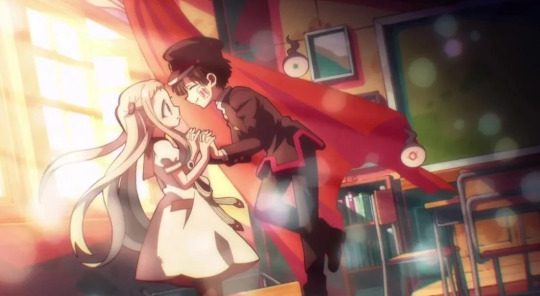
Kids on the Slope (2012)
If you love jazz, or history, or even heartwarming tales of friendship then this is the show for you. I will admit that is has a bit of a slow start, but by the time you get to the end you’ll be wishing for more.
In 1966, introverted classical pianist and top student Kaoru Nishimi has just arrived in Kyushu for his first year of high school. Having constantly moved from place to place since his childhood, he abandons all hope of fitting in, preparing himself for another lonely, meaningless year. That is, until he encounters the notorious delinquent Sentarou Kawabuchi.
Sentarou's immeasurable love for jazz music inspires Kaoru to learn more about the genre, and as a result, he slowly starts to break out of his shell, making his very first friend. Kaoru begins playing the piano at after-school jazz sessions, located in the basement of fellow student Ritsuko Mukae's family-owned record shop. As he discovers the immense joy of using his musical talents to bring enjoyment to himself and others, Kaoru's summer might just crescendo into one that he will remember forever.
My Rating: 6/10

Hyouka (2012)
Energy-conservative high school student Houtarou Oreki ends up with more than he bargained for when he signs up for the Classics Club at his sister's behest—especially when he realizes how deep-rooted the club's history really is. Begrudgingly, Oreki is dragged into an investigation concerning the 45-year-old mystery that surrounds the club room.
Accompanied by his fellow club members, the knowledgeable Satoshi Fukube, the stern but benign Mayaka Ibara, and the ever-curious Eru Chitanda, Oreki must combat deadlines and lack of information with resourcefulness and hidden talent, in order to not only find the truth buried beneath the dust of works created years before them, but of other small side cases as well.
My Rating: 6/10

Tonari no Seki-Kun: The Master of Killing Time (2014)
I absolutely adore this show. The episodes are only about 8 minutes long, and there is very little talking, yet the story still comes through perfectly. It never fails to brighten my day when I’m feeling down.
All Rumi Yokoi wants to do is focus during school, but she is constantly distracted by Toshinari Seki, her neighboring classmate. Paying attention during class is the least of Seki's worries, as he obsesses over intricate setups created using an assortment of items, from an elaborate domino course on his desk to a treacherous war played out with shogi pieces. Yokoi desperately attempts to focus in class, only to be repeatedly sucked into his intriguing eccentricities; however, they always seem to end up with her getting in trouble with their teacher. Fortunately, lessons will never be dull with Seki's antics around!
My Rating: 9/10

Classroom of the Elite (2017)
On the surface, Koudo Ikusei Senior High School is a utopia. The students enjoy an unparalleled amount of freedom, and it is ranked highly in Japan. However, the reality is less than ideal. Four classes, A through D, are ranked in order of merit, and only the top classes receive favorable treatment.
Kiyotaka Ayanokouji is a student of Class D, where the school dumps its worst. There he meets the unsociable Suzune Horikita, who believes she was placed in Class D by mistake and desires to climb all the way to Class A, and the seemingly amicable class idol Kikyou Kushida, whose aim is to make as many friends as possible.
While class membership is permanent, class rankings are not; students in lower ranked classes can rise in rankings if they score better than those in the top ones. Additionally, in Class D, there are no bars on what methods can be used to get ahead. In this cutthroat school, can they prevail against the odds and reach the top?
My Rating: 7/10

The Morose Mononokean (2016)
The start of Hanae Ashiya's high school career has not been easy—he has spent all of the first week in the infirmary, and his inexplicable condition is only getting worse. The cause of his torment is the mysterious fuzzy creature that has attached itself to him ever since he stumbled upon it the day before school began.
As his health continues to decline and the creature grows in size, Hanae comes across a flyer advertising an exorcist who expels youkai. Desperate and with nothing left to lose, he calls the number and is led to the Mononokean, a tea room which suddenly appears next to the infirmary. A morose-sounding man, Haruitsuki Abeno, reluctantly helps Hanae but demands payment afterward. Much to Hanae's dismay, he cannot afford the fee and must become an employee at the Mononokean to work off his debt. And to make things worse, his new boss is actually one of his classmates. If Hanae ever hopes to settle his debt, he must work together with Abeno to guide a variety of dangerous, strange, and interesting youkai back to the Underworld.
My Rating: 6/10

Beyond the Boundary (2013)
Another of my favorite aesthetically pleasing anime, this show has been the one that I show to friends who claim that anime cannot be beautiful (yes, several of my friends have actually said things along that line).
Mirai Kuriyama is the sole survivor of a clan of Spirit World warriors with the power to employ their blood as weapons. As such, Mirai is tasked with hunting down and killing "youmu"—creatures said to be the manifestation of negative human emotions. One day, while deep in thought on the school roof, Mirai comes across Akihito Kanbara, a rare half-breed of youmu in human form. In a panicked state, she plunges her blood saber into him only to realize that he's an immortal being. From then on, the two form an impromptu friendship that revolves around Mirai constantly trying to kill Akihito, in an effort to boost her own wavering confidence as a Spirit World warrior. Eventually, Akihito also manages to convince her to join the Literary Club, which houses two other powerful Spirit World warriors, Hiroomi and Mitsuki Nase.
As the group's bond strengthens, however, so does the tenacity of the youmu around them. Their misadventures will soon turn into a fight for survival as the inevitable release of the most powerful youmu, Beyond the Boundary, approaches.
My Rating: 7/10

Mekakucity Actors (2014)
I think about this show far more than I’d like to admit. The way they bring different plot lines together continues to amaze me 6 years after watching it for the first time.
On the hot summer day of August 14, Shintarou Kisaragi is forced to leave his room for the first time in two years. While arguing with the cyber girl Ene who lives in his computer, Shintarou Kisaragi accidentally spills soda all over his keyboard. Though they try to find a replacement online, most stores are closed due to the Obon festival, leaving them with no other choice but to visit the local department store. Venturing outside makes Shintarou extremely anxious, but the thought of living without his computer is even worse. It's just his luck that on the day he finally goes out, he's caught in a terrifying hostage situation.
Luckily, a group of teenagers with mysterious eye powers, who call themselves the "Mekakushi Dan," assist Shintarou in resolving the situation. As a result, he is forced to join their group, along with Ene. Their abilities seem to be like pieces of a puzzle, connecting one another, and as each member's past is unveiled, the secret that ties them together is slowly brought to light.
My Rating: 8/10

Angels of Death (2018)
You totally want to get emotionally attached to cereal killers, right? Of course you do, that’s why you should totally watch this anime.
With dead and lifeless eyes, Rachel Gardner wishes only to die. Waking up in the basement of a building, she has no idea how or why she's there. She stumbles across a bandaged murderer named Zack, who is trying to escape. After promising to kill her as soon as he is free, Rachel and Zack set out to ascend through the building floor by floor until they escape.
However, as they progress upward, they meet more twisted people, and all of them seem familiar with Rachel. What is her connection to the building, and why was she placed in it? Facing a new boss on each floor, can Rachel and Zack both achieve their wishes?
My Rating: 7/10

Bonus: Stars Align (2019)
I am adding one extra because this anime deserves so much more than it got. I adore every single character in this show and want nothing but to see them be happy. There is so much I adore about this show that I can’t put it all into words. I would recommend you watch this so you can share in my rage that the story was cut off halfway through with no current plans of completing it. There is no manga. There is no way of knowing what happens next. This recommendation is entirely for the purpose of generating more public outcry in the hopes that that causes them to finish the show. Please anime gods, if you are reading this I need to know what happens to my smol tennis boys. Are they safe? Are they alright?
Constantly outperformed by the girls' club, the boys' soft tennis club faces disbandment due to their poor skills and lack of positive results in matches. In desperate need of members,
Toma Shinjou is looking to recruit capable players, but he fails to scout anyone. Enter Maki Katsuragi, a new transfer student who demonstrates great reflexes when he catches a stray cat in his classroom, instantly capturing Toma's attention. With his interest piqued, Toma ambitiously asks Maki to join the boys' team but is quickly rejected, as Maki doesn't wish to join any clubs. Toma refuses to back down and ends up persuading Maki—only under the condition that Toma will pay him for his participation and cover other club expenses.
As Maki joins the team, his incredible form and quick learning allow him to immediately outshine the rest of the team. Although this gives rise to conflict among the boys, Maki challenges and pushes his fellow team members to not only keep up with his seemingly natural talent, but also drive them to devote themselves to the game they once neglected.
This story focuses on the potential of the boys' soft tennis club and their discovery of their own capability, while also enduring personal hardships and dealing with the darker side of growing up in middle school.
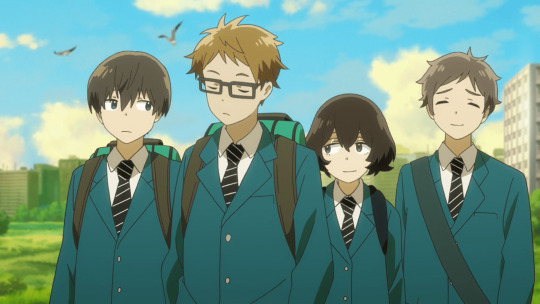
#anime#anime recommendation#zankyou no terror#terror in resonance#toilet bound hanako kun#kids on the slope#hyouka#tonari no seki kun#my neighbor seki#classroom of the elite#the morose mononokean#beyond the boundary#mekakucity actors#angels of death#stars align
81 notes
·
View notes
Text
20 Curious Facts About The “Old Lady of Vine Street,” The Cincinnati Enquirer
On Saturday, the Queen City’s last surviving daily newspaper celebrates its 180th birthday. Here are a few nuggets of Enquirer trivia.
A New York Birthday Twin The first issue of the Cincinnati Enquirer came off the presses on 10 April 1841. On the very same day in New York City, Horace Greeley published Volume 1, Number 1 of the New York Tribune. Merging in 1924 with the New York Herald, the New York Herald-Tribune eventually shut down in 1967.
What Goes Around . . . With all the debate about the voting rights these days, it is interesting that the lead story in the very first edition of the Cincinnati Enquirer consists of the entire text of a bill under consideration by the Ohio General Assembly “To Preserve the Purity of Elections.”
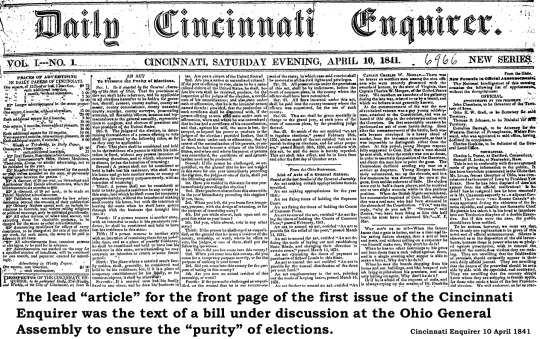
Publishing On The Sabbath On 20 April 1848, the first Sunday edition of the Enquirer appeared and created a great deal of controversy. Although it should be obvious that a Monday morning edition required a lot more Sunday labor than a Sunday edition, tut-tutting ensued. Only four other newspapers published Sunday editions in 1848 and all have ceased publication, so the Enquirer’s is the oldest Sunday edition in the United States,
Stop The Presses In its entire 180-year publication life, the Enquirer has failed to publish on nine days. For its first 102 years, the Enquirer missed only one edition when, in 1866, fire destroyed Cincinnati’s Pike Opera House and, with it, the Enquirer’s print shop. Since 1943, the Enquirer has failed to publish on eight days – all due to labor disputes.
Three Groans For The Francophile Rag When France and Prussia went to war in 1870, Cincinnati’s newspapers, fully aware of the Deutschland sympathies of their readers, quickly announced their support for Prussia. All but one newspaper, that is. The Enquirer proclaimed support for France, right up to Prussia’s crushing victory. A day after France’s surrender, Cincinnati’s Germans marched through the streets, stopping at every newspaper office to cheer. All but one. In front of the Enquirer, the crowd gave “three tremendous groans” of disapproval.
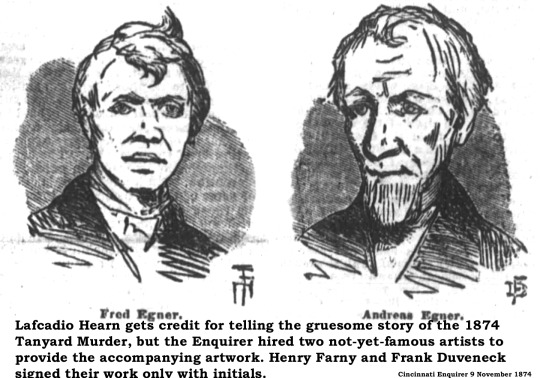
No Respect For Artists Lafcadio Hearn’s grisly reporting on the hideous crime known as the Tanyard Murder in 1874 is well known. It is not often remembered that two other major Cincinnati talents were involved in the dissemination of the gruesome details of this foul affair. Artists Frank Duveneck and Henry Farny – both of whom have multiple works on display at the Cincinnati Art Museum – provided the gothic sketches accompanying Hearn’s spine-tingling prose.
The Compositor’s Despair During the 1880s and 1890s, the sports editor of the Enquirer was a former news reporter named Harry Weldon. This was the era before typewriters when journalists turned in their copy on handwritten sheets. Weldon’s penmanship was so atrocious that few typesetters could decipher it. He was nicknamed “The Compositor’s Despair.”
Corrupting The Morals of Cincinnati’s Youth Cincinnati’s Roman Catholic Archbishop decried the Enquirer’s flagrant immorality in the 1880s, describing it as “a daily newspaper unfit to be read by any human being, much less a Christian.” The offending material? A “personals” column in the classified advertising section, through which young men and women arranged illicit assignations and prostitutes marketed their services.
Set ‘Em Up, Colonel! In 1899, the bonifaces of Cincinnati collaborated on a small book called “The Bartender’s Guide,” full of recipes for their signature cocktails. Colonel Thomas Cody, star mixologist of Covington’s Latonia Hotel, contributed the Enquirer Cocktail: A glass half-full of fine ice over which is poured a wineglass of imported sherry, a half glass of cream of cocoa, and eight to ten dashes of orange bitters, served with an orange slice.
Flowers For The Old Lady The deep ruby-red “Enquirer” carnation has been described as the most perfect cultivar of that species, mostly by the newspaper that sponsored a carnation-growing contest in 1899. Winning the plaudits, and a gold medal, was Richard A. Witterstaetter of Delhi, who bred this outstanding flower and named it after the newspaper who awarded him the gold medal.
Not Today, Madame! Under the iron rule of Marion Devereux, society editor of the Enquirer from 1910 to 1939, no respectable woman in Cincinnati would dare to select a convenient date for a luncheon, charity event or family wedding on her own. Every society matron in the Queen City religiously conferred with Miss Devereux to be assigned a date consistent with the regal editor’s social calendar.
His S.O.B. Book John Roll McLean was owner of the Enquirer from 1881 until his death in 1916. For a time, he was the unelected boss of Cincinnati, predecessor to George “Boss” Cox. McLean ran for office several times and always lost. He carried around a little notebook containing the names of people he particularly disliked. He called it his “Son-of-a-bitch Book.”
Diamond Connection Perhaps the most famous diamond in the world is the deep blue Hope Diamond now on display at the Smithsonian Institution. Few remember that this luxurious stone has a connection to the Cincinnati Enquirer. One of its owners was Edward Beale McLean, who owned the Enquirer (and the Washington Post) from 1916 to 1933. McLean bought the diamond for his wife, Evalyn. The diamond is reputed to be cursed. Maybe so; McLean died in an insane asylum.
The Rites Of Spring In the late 1940s and early 1950s, a young sportswriter named Whitney Tower gained a reputation as something of a character, even among the oddballs in the Enquirer newsroom. He was an excellent writer and turned out travel pieces as well as sports copy, but he really didn’t need the work because he came from wealth on both sides of his family. Every spring, he would enter the newsroom and proclaim a bawdy little ditty that began, “Hooray, Hooray, The First of May! Outdoor [lovemaking] begins today!“ Tower went on to cover horse racing for years at Sports Illustrated.
Owned By The Competition From 1956 to 1971, the Enquirer was owned by the E.W. Scripps Company, publishers of the competing Cincinnati Post. After buying controlling stock in the Enquirer, the Scripps Company purchased the only other remaining daily in town, the Times-Star, and merged it with the Post, leaving Scripps in control of every daily newspaper in town. Federal anti-trust regulators filed suit in 1964 and Scripps agreed to sell the Enquirer. Ironically, Scripps limped into a “joint operating agreement” with the Enquirer by the end of the decade in a last-ditch effort to save the Post.
Promo For A Face Change Throughout the summer of 1963, Enquirer readers found daily advertisements proclaiming nothing but “Bodoni Is Coming!” Curious subscribers called to ask whether it was a promotion for a trapeze artist or maybe a lawn fertilizer. On 30 September, the secret was out: The Enquirer had ditched Cheltenham, its long-suffering headline typeface for Bodoni Bold, adopted after much research into the optimum typeface to “give readers headlines they might read more quickly and with clearest possible understanding.”
I’m A Music Critic, Dammit, Not A Journalist! Longtime Enquirer classical music critic Henry S. Humphreys accompanied the Cincinnati Symphony Orchestra on one of its world tours. One night, he called the city desk to let the editor know he would not be filing a review of that day’s concert because the pilot got lost and landed the orchestra’s plane in the wrong city. He hung up on an editor dying for details but clueless as to where Henry had called from.
A Missed Bicentennial The Enquirer could have celebrated a bicentennial in 2018. Today’s daily newspaper traces its origins to a weekly launched on 23 June 1818 and originally named The Inquisitor and Cincinnati Advertiser. Over the next couple of decades, the paper was renamed The Advertiser, The Advertiser and Phoenix, and The Advertiser and Journal. Along the way, it began publishing twice a week and, in 1838, daily. On 1 April 1841, owner Moses Dawson sold the whole operation to the Brough brothers of Marietta, Ohio, John and Charles, who bought new type, but published from the Advertiser’s offices and presses 10 days later.
Happy Birthday! The Enquirer celebrated its 150th birthday on Wednesday, 10 April 1991, by publishing the news that the newspaper had won its first Pulitzer Prize ever. The prize was awarded in editorial cartooning for the work of cartoonist Jim Borgman, who had joined the Enquirer staff 15 years previously.
Grand Or Grey? Over many years, the Enquirer was known as the Old Lady of Vine Street, the title of Richard K. Mastain’s book on efforts to save the paper in the 1950s. Sometimes it was the Grand Old Lady of Vine Street. That’s the title of Grady DeCamp’s survey of Enquirer history published for its sesquicentennial in 1991. But, among competitors and targets of the Enquirer’s investigations, not to mention art & design critics appalled by its somber, bland layout, it was always the Grey Old Lady of Vine Street.

6 notes
·
View notes
Text
Hogwarts AU
In honor of Sobbe being Sobbe and BLESSING us with the Sobbe selfie that we’ve been wanting for years, here is the first time that Sander saw Robbe.
This is likely to be in the first chapter of my wtFOCK @ Hogwarts AU, which I decided will include some other POVs, but the main POV would be the main of that season. (Also, I changed Sander, Senne, and Noor’s ages to only being one year older than the main cast so I didn’t have to move up the timeline so “Season 3″ has to happen before Sander and Senne graduate).
Enjoy!
...
September 1st, 2018
Sander had spent the entirety of the train ride to Hogwarts in a compartment close to the front of the train where only the prefects and teachers sat. He had locked the door to the hallway, protecting it with a powerful charm that made people turn away, and closed the blinds so no one knew that he was in there. The only people who disturbed him was the sweet-cart lady, who he paid extra to keep his location a secret because he knew Senne was likely looking for him.
But, it had always been the same thing with the sole exception of their first train ride together, where they had met and traded their tragic life stories.
Senne would hang out with his other friends, and in later years his girlfriends who would hang all over him, and Sander would hide away in another compartment, sketching the scenery that they passed. It had become a routine that they had established, something they did every train ride, no matter the holiday. Senne would always find him on the platform without his other gang of friends and the girlfriend of the week, pretending to be angry that Sander didn’t want to hang out with him, and Sander would roll his eyes, letting Senne drag him to the carriages, teasing him for his anti-social behavior.
As the train started to slow down and Sander shifted to get up, his cat, Ziggy, who’s orange fur was more red than yellow, let out a frustrated meow, shifting and trying to burrow further into Sander’s lap. But, Sander picked him up by his sides, lifting him up and into the cage. He fought him, clinging to the outside of the cage until Sander pulled his claws from the edges of the cage, and meowed weakly for him to let him out, and Sander pouted all the same.
“I’m sorry, but the train is about to stop and you need to be in your cage for the house-elves,” Sander replied with a huff. He closed the cage and Ziggy protested again, louder. Sander pouted at him, grabbing his wand from his boot to vanish the cat hair from his black clothes. “Don’t make me feel worse.” Another protest as Sander pulled his robes out of his suitcase. “Ziggy.”
“Mrow,”
“Ziggy.”
“MROW.”
“The house-elves will let you out when you get in the room, I promise,” Sander informed him. The train slowed down completely, halting to a stop and nearly throwing Sander into the shelf above the seat. With seconds of the train halting to a stop, the younger years were racing off the train in the direction of the carriages. Ziggy glared at him all the same but allowed him to scratch under his chin through the bars of the cage. “I promise to give you all the love later tonight.”
After taking down the charm and pulling up the blinds, Sander exited his compartment, moving out of the train, following the rush of traffic until he jumped onto the platform. Sure enough, Senne was leaning against the same lamp light that he always was with Noor leaning up against him. The two of them were talking, their Gryffindor robes wrapped on his shoulders, the artificial light from the lamposts illuminating them in a warm glow, and Sander moved towards them, smiling over at Senne.
“There you are,” Senne remarked, halting his conversation with Noor with a simple shrug of his shoulders and a headshake. “Honestly, the number of times that you disappear from the train. I’m convinced that you don’t even want to be my friend anymore.”
Sander rolled his eyes. “As if. I don’t have to spend every waking minute with you, Senne.”
He pouted, looking like a child. “But I miss you.”
“You can survive the train ride without me,” Sander remarked. “You spent the majority of the summer over at my house, helping me steal my father’s alcohol, and you were definitely over at my house more than you were at yours. Not like I’m complaining, my mom loves you. You’re the son she always wanted.”
It was a joke, but it was also the truth because Senne was always nothing but respectful to Katrjin Driesen and protective of Camille within her fighting breath, and Senne knows it, reaching out to shove Sander’s shoulder.
“Besides,” Sander remarked, crossing his arms over his chest. “You know very well that Luka and I don’t get along.”
“You know I prefer you,” Senne teased. He reached out to grab at Sander’s jaw, snagging it beneath the pads of his fingertips, and purposely jetting his lips forward. Sander leaned from his grasp, slapping his hand, and Senne let out a booming laugh, followed quickly by Noor’s melodious laugh. “But, Luka throws wicked parties when his parents are away. You should go sometime, I’m sure you’ll have a blast.”
“He’d probably sit on the couch and people watch,” Noor commented.
“Exactly! There’s always an interesting amount of characters at Luka’s parties, but you never show up. You never know who you might meet,” Senne remarked.
“I already see enough of Luka in our dorm and that’s enough for me.”
“Just because you go to his party doesn’t mean you have to see him.”
“I’m never invited.”
“I’ll invite you!”
“But, I don’t want to go!” Sander responded. Senne laughed loudly, wrapping an arm around Sander’s shoulders (which had become increasingly more difficult now that Sander was taller than him) and dragging him in the direction of the thestral-drawn carriages. Noor followed behind as Sander tried to free himself from Senne’s iron-clad grasp.
The crowd on the platform had already begun to thin considerably. Everyone had been eager to get on the carriages, to be whisked away to the castle, as if that would somehow make the food and sorting ceremony happen quicker. Senne returned to his conversation with Noor, which seemed to have been about Professor Potter’s short summer project, picking a topic from the next book that they wanted to learn about and explain why.
Up ahead, there was a group of fifth years, hanging outside one of the carriages. There were only two of them that he recognized, Jens and Moyo, and only because Jens frequently ended up in the Slytherin Common Room when he was dating Britt and Moyo seemed to have a crush on Noor (much to her annoyance). One of them was a long-haired girl, another Gryffindor, with her long hair tied up into a ponytail, reaching out to pet the thestral.
To Sander, she was petting air. But Sander had known of thestrals since his second year.
Senne could see them, had the entire time, but the two of them hadn’t been able to understand why Senne could see it and Sander couldn’t. The Head Boy had explained to them about thestrals and how only certain people could see them and Senne guided him to feel the snout of the horse-like creature. It was freaky, being unable to see something but feel it’s leathery, smooth skin beneath your fingertips.
The girl reached out, snagging someone’s wrist, pulling them closer.
It was a boy, a Ravenclaw judging from the blue and bronze on his robes which hung on his shoulders, with brown hair that curled at the end, long enough to be pulled into a small ponytail at the nape of his neck. There were a few strands that broke free of the ponytail, falling on the sides of his face, framing his features beautifully, stunningly. They were a little far from the artificial light of the platforms, the moon shining on all of them, on him, as the girl placed his hand against the snout of the thestral.
A bright grin formed on the boy’s face, his grin lighting up his entire face, accenting it beautifully and perfectly, as his hand moved along the snout, petting it with the best of his ability, considering the fact that he (presumably) couldn’t see the beast, and Sander was almost glad that his friends weren’t paying attention to him because Senne would tease him for days and so would Noor. But, his soul screamed at him, him.
Him.
That’s him.
“Come on,” Jens spoke, climbing into the carriage, joining the curly-haired boy already sitting there. “Let’s go before they start the feast without him.” The girl climbed on the carriage, sitting down next to Jens and taking his hand. There was a look exchanged between Moyo and the boy as to who would get the final seat before they were off.
Within an instant, the boy was around the thestral, climbing over the carriage side. The move was swift and agile, like he was born to do it, plopping down in the fourth and final seat of the carriage, before Moyo even had a chance to move that far. He let out a string of curses and the carriage took off, having automatically filled its four-person quota. Jens and the girl laughed.
“Sorry, Moyo!” the boy called, grinning brightly.
“That’s completely unfair! You’re too fucking small!”
“That’s why he’s the Ravenclaw Seeker!”
Fuck, Sander thought to himself. How had he not noticed him before now?
Sander felt someone brush up to him and he turned to find Senne, nudging him with his shoulder and a concerned look on his face. “You okay?” Senne questioned. Noor popped up on Sander’s left, glancing at him as well.
Sander nodded his head, wanting to have this conversation with his best friend later when it was just the two of them. “Yeah, I’m fine. Was just watching that interaction is all,” Sander commented, pointing at Moyo, who was staring at them, presumably Noor, now.
Noor glanced ahead of them, letting out a frustrated breath, hissing out, “Oh, fuck me. Just what I need.”
Sander reached out, wrapping an arm around her shoulders and bringing her close to his side. He could see the disappointed, but not surprised, look on Moyo’s face, but he placed a kiss against the top of Noor’s hair for good measure. “I got you.”
Noor laughed, reaching up to intertwine their fingers, as Senne stepped towards the next carriage, laughing under his breath. “Thank you, Sander, the best fake-boyfriend I could ever ask for.”
#brenna writes#brenna's hogwarts au#slytherin!sander driesen#ravenclaw!robbe ijzermans#gryffindor!jens stoffels#gryffindor!senne de smet#gryffindor!noor bauwens#gryffindor!moyo makadi#hufflepuff!aaron jacobs#gryffindor!jana ackermans#sobbe#rosander#sander x robbe#wtfock#wtfock hogwarts au#wtfam
128 notes
·
View notes
Text
The Real Story Behind The Slender Man: EVERYTHING You Need To Know
It started in May 2014.
Three teenage girls were enjoying a Wisconsin summer evening when they decided to go for a walk in their local forest.
Only two of them would return.
The third would be stabbed 19 times by her friends.
She survived, pulling herself out of the forest and to safety. Her classmates were promptly arrested, and confessed their crime, later going on to plead insanity.
Yet despite the shocking nature of this crime, a stabbing doesn’t necessarily make worldwide news. But it wasn’t the circumstance of the attack that hit the headlines. It was the motive.
They claimed they did it to appease the Slender Man.
And they were not the only ones that committed such a crime in his name.
To a majority of the population, these claims can be written off as the ‘insanity’ stamped on the official court documents. But the thing is, these atrocities aren’t the only times Slender Man has been sighted outside of his pixelated world.
In fact, Slender Man made his name many years before we began our search for the 8 pages.
Does he really only exist within the World Wide Web?
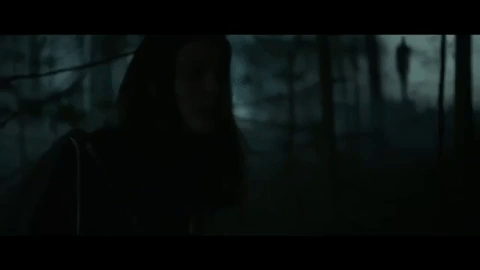
What Is The Slender Man?
Our story starts 5 years before Wisconsin hit the headlines.
In 2009, comedy website Something Awful launched a paranormal images competition. Users of the website were to mock up supernatural-inspired or horror-themed pictures, and leave them to be judged by the internet.
Eric Knudsen’s entry forged together the mystery of an urban legend and the dark reality of pedophilia.
Knudsen used pictures of children playing in playgrounds, or hanging out in friendship groups, or any other innocent gathering of youngsters, and photo-shopped a figure among them. This figure was an 8 foot tall, thin man, with a faceless, pale profile draped in a formal suit.
Emerging from his back was a set of dark, twisting tentacles.
He called him the Slender Man.

It was only when 4chan users picked up on these pictures that his urban legend infamy was set in stone.
Both the forum site and Creepypasta.com moulded his backstory, infusing the simple tales of kidnapped children with the concept of proxies - that is, children which were used to do his bidding. And it’s this premise that would alter the landscape of teenage crime - and suicides - in America.
From here the urban legend extended its tentacles, haunting the darker corners of the internet. But it was his debut in video games that drew him out into the mainstream.
In 2012, the first video game first entered our downloads folder.
The free game followed a simple principle: you wander through dark woods in the dead of the night armed with a torch and surrounded by pixelation only an early Buffy demon could muster up, and you look for 8 ‘pages’.
These pages are poorly pencilled drawings that have been left by children taken by the Slender Man - but the terror only starts here. Throughout your search you are followed by the entity titling the game.
Slender Man: The Arrival hit the shelves only two years later and followed the same concept as the original. But this time we are joined by some sense of a plot, and a few other characters, too.
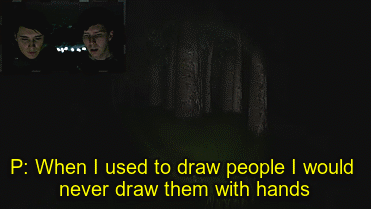
Nevertheless, the undying premise remains: he follows kids, and then he takes ‘em for himself.
Why?
This remains unknown.
But it’s this premise which fuelled the urban legend haunting the teenagers, fitting the real life cases that have scarred America.
This was confirmed in his film debut in 2018: Slender Man preyed upon the wave of crime inspired by the creepy pasta, merging the reality of the recent stabbings with the video games that put him on the map.
But this premise has scored a stab wound on our society before, fitting historic folklore far too accurately.
Crime In The Name Of The Slender Man
Wisconsin was not the only American state to witness a shocking crime inspired by this indie horror icon. In fact, a variety of other attacks pinned on the Slender Man followed a similar pattern:
One 14 year old burnt their house down, a tragedy linked to their history of reading creepypastas exploring the legend, whilst another young teen stabbed her own mother in order to please the Slender Man.
But it doesn’t stop there.
Alongside the spike in violent crime was a sharp rise in teenage suicides at the Pine Ridge Native American Reservation.
The suicide rate among the Native American population in America is already far more prevalent than any other ethnic group, but the sudden spike of 9 suicides of those aged between 12 to 24 sparked concern. And when the motives were drawn back to the Slender Man, these concerns only grew further.
The authorities even made mention to this urban legend in their official investigation, determining that the Slender Man was considered by the teenagers in the community to be a suicide spirit, a dark entity within Native American folklore. But to them, the Slender Man went by a slightly different name.
They called him the Tall Man spirit.
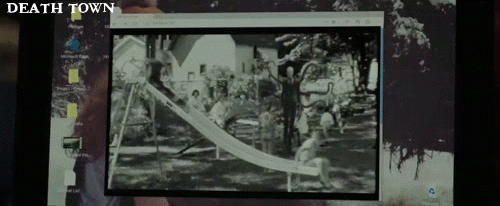
“He’s appearing to these kids and telling them to kill themselves.” - a local minister who supported youths in the community
Suicide spirits follow a similar line of thought to Catholic views of demons or evil spirits: they are negative spirits that feed off our energy. This entity in particular, however, spends its free time targeting and possessing individuals that are undergoing a spiritual crisis.
Alcoholics, addicts, the depressed - they are all worthy contenders for being the personal buffets of suicide spirits.
With a cluster of Facebook videos alluding to local folklore combined with viscous cyber-bullying encouraging the victims take their own lives, the notion of the Tall Man gathered strength, tying together the folklore of the suicide spirit and the urban legend of the Slender Man.
But this wasn’t the only time the Tall Man has been sighted in Native American communities.
In 1890, the Wounded Knee Massacre occurred.
20,000 Latoka Native Americans were left for dead by US troops. To this day it is considered one of the most atrocious acts committed against the Native American population.
And it was here that the Big Man was first seen.
Many claimed an entity taking the form of a tall man sporting a top hat would wander the reservation after the massacre, and made the younger generation take their own lives.
Whilst negative spirits donning the top hat are common outside of Native American folklore, the similarities between the Big Man and the Tall Man create an uncomfortable link between the tragedies scarring the past and present Native American population.
But this community’s folklore isn’t the only place the Slender Man has been referenced outside of the video game.
Nearly every other culture has their very own Tall Man.
Could the Slender Man have existed before the original video game even entered beta testing?
The Slender Man In Historic Folklore
When I began researching the entity’s existence - aside from being overwhelmed by the array of tragic stories - I encountered many dead ends.
One of these dead ends sticks out.
Out of all of the rumours circulating following the Wisconsin stabbings was that Slender Man originated from Romanian folklore, and was based on some similar entity possibly bearing his size, demeanour, and pastime of abducting and/or traumatising children.
This was proven to be untrue.
But upon realising the Slender Man didn’t first make his name in Romania, I discovered he had made his name in a lot of other countries.
Like a lot.
Like way too many.
From motive to dress sense, the Slender Man’s first sighting starts a couple millennia before his internet debut.

Fear Dubh from Irish folklore is the most popular contender for being the OG Slender Man, his name literally translating to ‘Black Man’. It is claimed that this entity would scare children snooping round the woods, and his title confirms his attire matches his more modern formal suit.
Germany’s Eriking too bears a resemblance to the Slender Man’s irish counterpart - with a focus on both his height and dark clothing, this internet icon might have travelled further than we think. This mythical beast prides himself on dwelling in the woods and kidnapping children, confirming he has potential for the official historic Slender Man.
However: the plot thickens when we consider another German entity known only as the Tall Man.
With the same name as the Native American suicide spirit, and the guiding principle of kidnapping kids who wander the woods, the potential for an international entity once again emerges from the darkness.
Historic legends from the American South also contain a similarity that should have you sleeping with the light on: a treelike man who kidnaps children was often spotted throughout history.
Regardless, it’s easy to decode these vague mythical creatures as warnings to their children of the dangers of wandering near uncharted territory alone and at night.
But it’s the details of the Slender Man that click together when we trace the folklore back to the oldest recorded sighting of the urban legend.
And this takes us to 9000 BC.
Both Eypgtian hieroglyphics and Aztec paintings often portray the same distinct tall, thin, menacing figure, but it’s Brazilian cave paintings that house the oldest attributes.

In these paintings you can clearly see a tall man lead a child by the hand, his unnaturally large limbs dominating the scene.
Yet aside from the Slender Man’s basic features - that of his height and incessant stalking of children - his facelessness (#new-word) is a feature we have yet to discuss. Fortunately, many cultures have already discussed it. And the greatest conversation takes place in Japan.
Japanese faceless ghosts have haunted the small island for centuries. The Noppera-bo prides itself on frightening humans, often taking the face of someone the victim knows before their features dissipate into nothingness.
All you can see is a blank, smooth, flat layer of skin, a sight only witnessed when the Slender Man finally catches up with you in his video game debut.
Whether you believe in the Slender Man or not, there is no doubt that the concept harnessed by Eric Knudsen did not begin in 2009.
We might not know when the Slender Man began hunting children, and we might not know why he does, but there is one thing for certain:
He has not finished just yet.

If you liked this post, chances are you’ll like my other posts, too! You will have to come out from beyond your quilt, though.
Make sure you hit follow if you want to see more stuff like this - and, you know, less traumatising posts about the paranormal every week.
Don’t forget to join my ghost hunt, too, where I post a new real ghost story everyday!
#slender man#Slenderman#slenderverse#slender the arrival#slenderman video game#creepypasta#jeff the killer#candle cove#ticci toby#urban legend#urban legends#scary urban legend#scariest urban legends#creepy urban legend#native american folklore#paranormal#supernatural#Ed and Lorraine Warren#zak bagans#real urban legends#mythical creatures#paranormal evidence#photographic evidence of ghosts#video games#horror movies#slenderman movie#8 pages#horror video games#wounded knee#slender man real
68 notes
·
View notes
Text
I wondered why it seems that the quality of Rick’s writing went downhill and decided to do some research into his publishing schedule after he began writing the Percy Jackson universe.
2005 - Mission Road / The Lightning Thief
2006 - Sea Of Monsters
2007 - Rebel Island / Titan’s Curse
2008 - Battle Of The Labyrinth / Demigods + Monsters / Maze Of Bones
2009 - The Last Olympian
2010 - Ultimate Guide / Red Pyramid / The Lost Hero
2011 - Vespers Rising / Throne Of Fire / Son Of Neptune
2012 - Serpents Shadow / Kane Survival Guide / Demigod Diaries / Mark Of Athena
2013 - Demigod Files / House Of Hades / Som Of Sobek
2014 - Greek Gods / Blood Of Olympus / Staff Of Serapis
2015 - Greek Heroes / Demigods Of Olympus / Sword Of Summer / Crown Of Ptolemy
2016 - Hammer Of Thor / Guide To Norse Worlds / The Hidden Oracle
2017 - Camp Half-Blood Confidential / Ship Of The Dead / The Dark Prophecy
2018 - Magician’s Manual / 9 From The Nine Worlds / Burning Maze
2019 - Tyrant’s Tomb
2020 - Tower Of Nero / Camp Jupiter Classified
Conclusions: Rick has been writing 1-2 full length novels every year as well as 1-2 novellas since Disney took over his contract in 2010. Only in the past two years (2019 and 2020) has this changed to a schedule like his early writing days.
27 notes
·
View notes